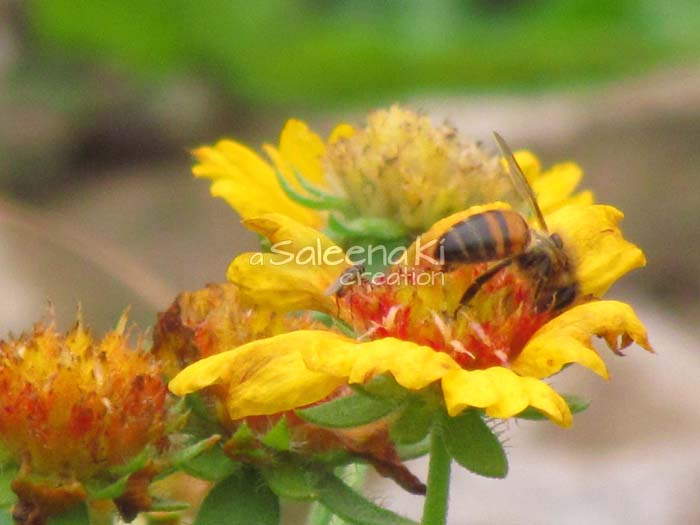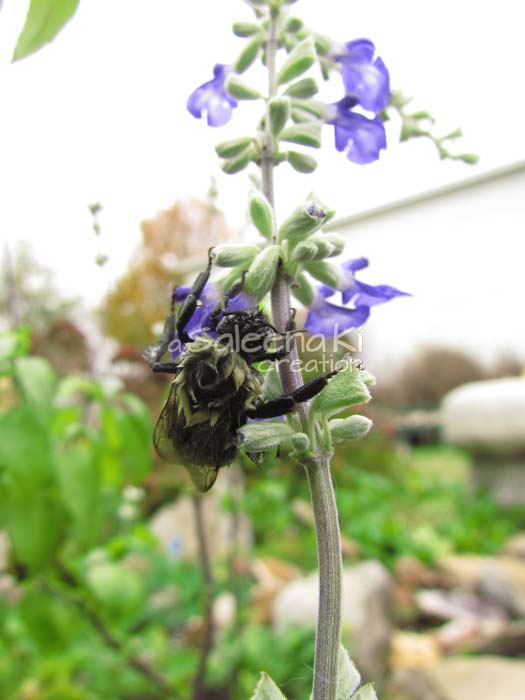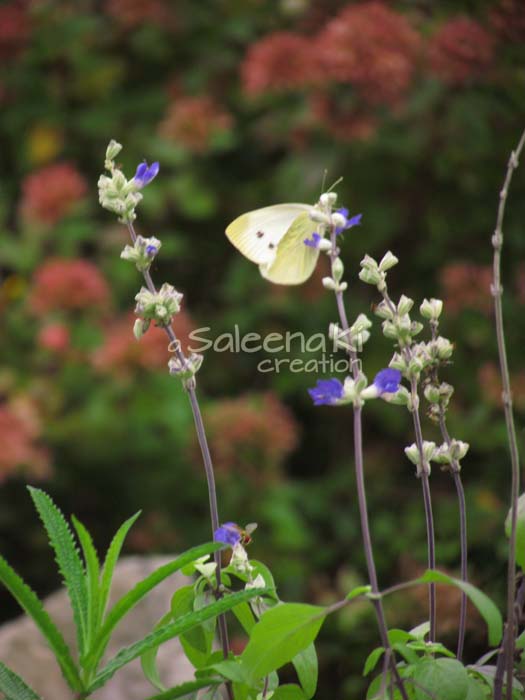
22 Mar BEE Friendly Habitat-Protect our Pollinators
![save_our_bees_237x30[1]](http://saleenaki.com/gardensong/wp-content/uploads/sites/22/2016/03/save_our_bees_237x301.png) Pollinator Habitat
Pollinator Habitat

Bumble Bee nosing into Salvia I planted from seed in the Fairy Garden. Mother Nature grew it.
♥
Here at GardenSong2 in our Tennessee Motherland, Hugh and Nell started their next Tree planting project for the Pollinator Habitat. Our Pollinator Habitat, or Butterfly Sanctuary, is on about 1.5 acres of land across the street from where we live. This year we’ve planted 21 Chestnuts, 9 Paw Paws (Persimmons) in the understory and have Beauty Berry bushes to go. Last year we planted Indigo Bushes along the Dry Creek, and Silky Dogwoods, Cedars, Cypress, Eastern Ninebarks, Staghorn Sumac, Beauty Berry, Elderberries is the Habitat.
This family project is focused on removing invasives that crowd out the supportive plants, flowers and trees and encouraging plant life that feeds and enhances the lives of our precious Pollinator friends, Bees, Butterflies, Flies, and other pollinators. The land is also is being shaped and designed to provide various kinds of habitat for many small animals, amphibians, reptiles and birds. This is only our second year so it will be exciting to see how many of the wildflowers return from the plantings last year.
So you see, to us, supporting and enhancing our land to help preserve and encourage our Pollinators is really important. In fact it is a critical factor in all of our lives.
How Do We Protect Our Pollinators?

2 kinds of Bees on Rusty’s Calendula.
The seeds came from a Calendual in a little pot given to my Mom when my youngest brother was killed at 6 years old.
She planted it in her garden in Utah. That was in 1973. That means this plant has lived with us for 43 years!
I brought seeds home with me in 2012 and planted them. I was so happy when the first little sprouts appeared. This plant is particularly precious to me! They have lived and bloomed in GardenSong TN for 3 years now.
They make many new seeds every years and I gather them, so who knows how long this plant will continue with us.
I was so happy when the Bees and Butterflies loved them.
♥
Time to Buy Plants & Seeds
Many of you are already buying and sprouting seeds for your gardens, planning your Spring activities. Prepping beds and counting seeds. Whether they are for Container Gardens on your deck, Flower beds in your yard, vegetable and herb gardens for your and your family, sprawling magnificent Estate Gardens that require many hands to manage and care for, or farms, one BIG consideration this year is what are we doing to either protect or harm our Pollinators?
It is mid March and I have already seen our first Tiger Swallowtails, Cabbage Whites, Buckeye and maybe Cloudless Sulfur Butterflies. I have seen a few sleepy Honeybees and the friendly Carpenter Bees are out in full flight now.
If you care about protecting our Pollinators, if you care about protecting our ecosystem, if you care about preserving a healthy food system on our planet, then it is time to pay attention. When it is time to start buying plants or seeds it is time to start considering where you can buy them from that is free from Neonicotinoid and other harmful toxic pesticides.
Last Year I Faced the Awful Truth
Last year I faced the awful truth that even though I am pretty conscious about pesticides and don’t use them in my organic and natural gardens, I had been buying plants and flowers from our local retailiers that were laced with a toxic systemic pesticide called Neonicotinoid. The terrible trouble with this one is it is systemic, which means that if it is applied to any part of the plant at any stage, from seed to full grown plant, including the flowers, this insect killer moves into every part of the plant. Not only that, it can then leach out into the neighboring soil and infect neighboring plants.
Well suddenly all the main sources where I was buying my plants from were no longer valid options. I was astonished (and rather upset with myself and the stores and growers that are unconsciously or consciously making these toxic lethal choices for whatever reasons) and I actually went into mourning for my friends that I may have unknowingly hurt. So I began to pay much more attention to what I was doing. This led me to begin to research this whole issue and educate myself about what to do about it.
First of all what is so terrible about using
Neonicotinoid Pesticide?

![]()
It kills insects! And Bees, Butterflies and Flies are insects. They are Pollinators and Pollinators are necessary for our lives, as Humans on Earth, to continue to have a healthy food and ecosystem on our planet. Our Pollinators are in trouble, so that means we are in trouble. Here is are some quotes from one article that addresses this:
Ask Ruth: Finding Neonicotinoid-Free Plants
for Pollinator Gardens
” Pollinators (Honey Bees) are battling Colony Collapse Disorder (CCD) and a complex mix of issues. Neonicotinoids (a class of insecticides) are just ONE of the issues. It will be impossible to touch on all of the complexities of this topic in this short article.
It’s serious business. About one third of the food WE eat (including foods for meat animals) depends on pollination to occur, and pollinators are in crisis. This issue strikes at the heart of food security for all human beings and most of Earth’s creatures. European honeybees, native bees, butterflies, bats, hummingbirds, flies, and mammals are some of the creatures that aid in pollinating plants. In 2013, the USDA expressed concern that there may not be enough pollinators to support major US crops of blueberries, apples, avocados, and more.
The thing is…everything is connected. Pollinators are experiencing pressure on many fronts. Habitat loss is huge – everything from farm field expansion and new developments in our towns, to loss of (weed and border) habitat due to Roundup-ready crops which are diminishing pollinator habitat. Additionally, parasites and diseases challenge the honeybee’s immune system. And then there is the complicated topic of pesticides, including neonicotinoids. Beyond single insecticides, multiple pesticides and fungicides can add up synergistically, the combination being worse than the individual parts.
Bees and most of our pollinators are insects, and insecticides are designed to KILL insects. Harming pollinators is the unintended, but inevitable consequence of pesticide use in agriculture, and in home gardens and landscapes. Wake-up-call for gardeners: according to the Boston Globe, “The average lawn gets up to 10 times as much pesticide per acre as farmland”, so farmers aren’t our only concern. We are talking about our own back yards.” Source: Ruth Gonzales Organic Growers School
So the BIG QUESTION I have this year is
WHERE CAN I GET PLANTS
that are SAFE for my POLLINATORS and for US?
I called around and talked to a few of the local nurseries. What I found was that the biggest problem is that it is the Growers that use these toxic pesticides and fertilizers. One man I talked to that works for one of the bigger nurseries in TN, said that it is very very hard to find growers that provide organic or pesticide free plants and that my best bet was to buy organic seeds and grow my own. He said he would pass my concerns on to the one who orders the plants.
Then I looked online to see if any of the big retailers like Lowe’s, Wal-Mart or Home Depot are safe to buy from this year (2016). Home Depot looks like they are now labeling their plants with an ingredient list. Interesting… At least I can choose ones that are neonicotinoid free.
I found an article from April 09, 2015
Lowe’s To Stop Selling Neonicotinoid Pesticides That May Be Harmful To Bees
“The class of pesticides known as neonicotinoids, or neonics, are sold by agrichemical companies to boost yields of staple crops but are also used widely on annual and perennial plants used in lawns and gardens.
Scientists, consumer groups, beekeepers and others say bee deaths are linked to the neonic pesticides. The bee die-off is worrisome for agriculture because honeybees pollinate plants that produce about a fourth of the food consumed by Americans.”
“A study released by environment group Friends of the Earth and Pesticide Research Institute in 2014 showed that 51 percent of garden plants purchased at Lowe’s, Home Depot and Walmart in 18 cities in the United States and Canada contained neonicotinoid pesticides at levels that could harm or even kill bees.”
“Lowe’s said it will phase out neonics in shelf products and plants by the spring of 2019, as suitable alternatives become available.”
That is actually too many years for me to wonder and to support a company that will continue to sell plants that will harm our Pollinators. I won’t shop at Lowe’s again until I am sure they are making responsible choices to help preserve our Pollinators.
” Home Depot, the largest U.S. home improvement chain, also asked its suppliers to start labeling any plants treated with neonics and that it was running tests in several states to see if suppliers can eliminate neonics in their plant production without hurting plant health.”
Now that makes me more inclined to give Home Depot some of my business.
Another article from JUN 26, 2014 :
“Bee-friendly” plants sold at Wal-Mart, Home Depot actually contain bee-killing pesticides
“A task force set up by the International Union for Conservation of Nature released the results of a four-year meta-analysis finding what it says is “conclusive” evidence that the pesticides are “a key factor in the decline of bees” — and are responsible for a host of other environmental problems to boot. One scientist with the task force called the chemicals the “new DDT” — except worse, because they wipe out the bottom of the food chain, and they’re 5,000 to 10,000 times more toxic. By now, the only people who don’t think there’s any link between the pesticides and bee die-offs are, predictably enough, the people who manufacture them.
Frustrating as it is to watch evidence of a problem build without enough being done to counteract that problem, bee advocates insist that planting bee-friendly gardens can go a long way toward helping the struggling insects thrive. But the Pesticide Research Institute and environmental group Friends of the Earth just dropped this bombshell: More than half of the purportedly “bee-friendly” plants sold at Home Depot, Lowe’s and Wal-Mart garden centers across the U.S. and Canada actually contain neonicotinoids — meaning gardens planted to save the bees, or even just planted under the assumption that they aren’t contributing to the die-offs, instead may be killing the pollinators.”
“Wired took an in-depth look at the report, which it calls “one of the most comprehensive investigations yet of an often-overlooked source of neonicotinoids in the environment: gardens and the built landscape”:The researchers purchased 71 bee-friendly plants—including daisies, lavender, marigolds, asters and primrose—at 18 Lowe’s, Walmart and Home Depot outlets across the United States and Canada. For more than half of the plants, the researchers measured neonicotinoid residues in the flowers at levels between 2 and 748 parts per billion.
According to ecotoxicologist Vera Krischik of the University of Minnesota, who was not involved in the study but reviewed it in detail, the data is solid and troubling. A dose of 192 parts per billion is enough to kill a honeybee, she says, and dozens of studies have found impairments in bee navigation, memory and foraging ability at between 4 and 30 parts per billion.
These exposures may pose an especially grave threat to wild pollinators. While problems with domesticated honeybee hives are well-publicized, many populations of wild bees and butterflies are also in precipitous but comparatively ignored declines. The life cycle of wild bees leaves them highly vulnerable, says Krischik: While domesticated honeybee hives contain thousands of workers, and can handle some losses, many wild bees live in small hives containing perhaps several dozen workers.
We’re still waiting on the U.S. to make like the EU and ban the most toxic neonicotinoids, at least temporarily. In the meantime, Friends of the Earth is calling on consumers to put pressure on retailers to take initiative to ditch the pesticides themselves.”
“Most gardeners have no idea that their gardens may be a source of harm to bees,” said Lisa Archer, director of the Food & Technology program at Friends of the Earth, in a statement. “We’re calling on retailers to get neonicotinoid pesticides out of their plants and off their shelves as soon as possible. Until then, gardeners should buy organic plants to ensure the safety of bees.” Article by Lindsay Abrams
Well I looked and didn’t find anything about the progress of all of this in 2016. I am unsure about Wal-Mart.
The only article I found in my first round of looking for where to buy Neonicotinoid-free plants or seeds is from North Coast Gardening. I am in middle Tennessee so it helps some, I can order seeds:
Buying Bee-Friendly Plants: Neonicotinoid-Free Nurseries, Growers, and Seed Sources
They offer some lists:
Nurseries that DON’T use neonicotinoid pesticides
Nurseries that DO use neonicotinoid pesticides (do read their explanations)
It gives you an idea of the way people are thinking!
Home Depot May Be Labeling Plants

Cabbage White on Salvia I planted from seeds in the Fairy Garden
Well, with all that it looks like I might be able to buy some plants from Home Depot. I will have to go see if they do label them. And I will have to start most of my flowers from seeds this year. Alas for me, the more I know, the more responsibility I must take to make sure my Pollinators and the planet is safer because of my choices! Reality is that knowing does make things more complex and sometimes not as easy. Though for me, it is worth it.
I hope this helps inspire you and gives you some ideas about how to begin making better choices for your own Gardens this year. I hope you have better choice of where to buy then I do. I hope we all sit up and take action to help preserve our Pollinators. I would like to keep eating…
![]()
♥
